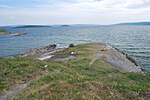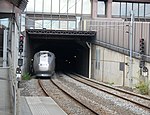Heggholmen Lighthouse
1827 establishments in NorwayLighthouses completed in 1827Lighthouses in OsloListed lighthouses in NorwayNorwegian lighthouse stubs ... and 1 more
Oslo geography stubs

Heggholmen Lighthouse (Norwegian: Heggholmen fyr) is a coastal lighthouse located in the Oslofjord, in the municipality of Oslo, Norway. It was established in 1827, and automated in 1972. The lighthouse was listed as a protected site in 1998.
Excerpt from the Wikipedia article Heggholmen Lighthouse (License: CC BY-SA 3.0, Authors, Images).Heggholmen Lighthouse
German Bunker, Oslo Gamle Oslo
Geographical coordinates (GPS) Address Nearby Places Show on map
Geographical coordinates (GPS)
| Latitude | Longitude |
|---|---|
| N 59.885277777778 ° | E 10.713888888889 ° |
Address
German Bunker 9
0150 Oslo, Gamle Oslo
Norway
Open on Google Maps










